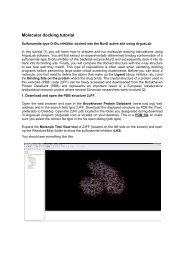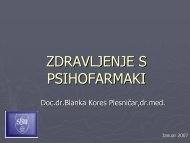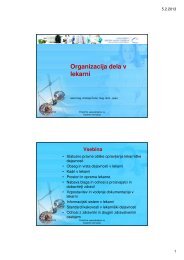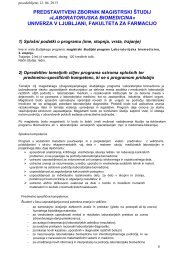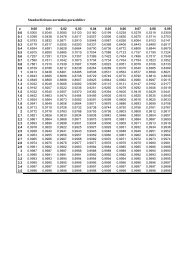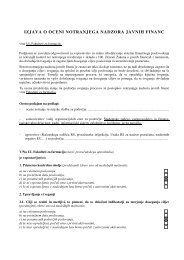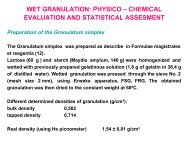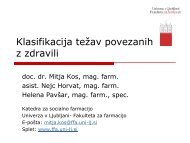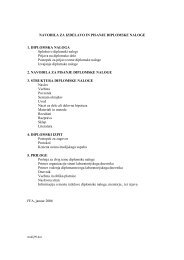Na izsledkih temeljeÄa medicina Na izsledkih temeljeÄa medicina
Na izsledkih temeljeÄa medicina Na izsledkih temeljeÄa medicina
Na izsledkih temeljeÄa medicina Na izsledkih temeljeÄa medicina
Create successful ePaper yourself
Turn your PDF publications into a flip-book with our unique Google optimized e-Paper software.
Univerza<br />
v Ljubljani<br />
Fakulteta<br />
za farmacijo<br />
<strong>Na</strong> <strong>izsledkih</strong> temelječa a <strong>medicina</strong><br />
doc. dr. Mitja Kos, mag. farm.<br />
Katedra za socialno farmacijo<br />
e-pošta:<br />
mitja.kos@ffa.uni-lj.si
Viri informacij<br />
• biomedicinske revije<br />
• pogovori s kolegi, ki imajo posebna znanja<br />
• predavanja in seminarji<br />
• informacije oz. “oglasi” v revijah<br />
• pogovori s predstavniki farmacevtske<br />
industrije<br />
• ipd.
Vrednotenje informacij<br />
• Katere medicinske izsledke je smiselno in<br />
koristno vključiti v klinično no prakso
Kritična presoja (ang. Critical<br />
Appraisal)<br />
• Canadian Medical Association Journal<br />
• serija člankov v 80. letih<br />
• Klinični epidemiologi s kanadske univerze<br />
McMaster<br />
• namen: zdravnikom svetovati kako naj berejo<br />
klinične ne revije<br />
Vir: Anon. How to read clinical journals: I. Why to read them and how to start reading them critically. Can Med Assoc J<br />
1981;124: 555–8.
Kritična presoja (ang. Critical<br />
Appraisal)<br />
• Tradicionalni pristop zajema:<br />
• intuicijo<br />
• posameznikove klinične ne izkušnje<br />
• poznavanje načel patofiziologije<br />
• Nov pristop “kritične presoje”:<br />
• v klinično no prakso vpeljati znanstvene izsledke iz<br />
medicinske literature ter le-te dejansko uporabljati pri<br />
kliničnem nem odločanju in delovanju.
Evidence- based medicine<br />
• Termin EBM (Guyatt 1991)<br />
• “Vestna, nedvoumna in razumna uporaba<br />
trenutno najboljših izsledkov v odločanju o<br />
medicinski oskrbi posameznega bolnika”<br />
(Sackett DL in sod. 1996)<br />
Vir: Guyatt GH. Evidence-based medicine. ACP Journal Club 1991; 114: A–16.<br />
Sackett DL, Rosenberg WMC, Gray JAM, Haynes RB, Richardson WS. Evidence based medicine: what it is and what it<br />
isn’t. Brit Med J 1996; 312: 71–2.
<strong>Na</strong> <strong>izsledkih</strong> temelječa <strong>medicina</strong><br />
• Poredoš P, Šabovič M. Strokovne podlage za<br />
razvrščanje<br />
anje zdravil glede na učinkovitost. Zdrav<br />
Vestn 2000; 69: I–15I<br />
15–7.<br />
• Komadina R, Rok-Simon M. Desetletje gibal<br />
2000–2010 2010 pod okriljem Svetovne zdravstvene<br />
organizacije. Zdrav Vestn 2001; 70: 493–5.<br />
• Fuerst J. Odmev na članek<br />
»Zdravljenje<br />
rezistentnih depresij in primer uspešne uporabe<br />
donepezil HCl v njihovi obravnavi«. . Zdrav Vestn<br />
2002; 71: 115–5.<br />
5.
Znanstveno utemeljena <strong>medicina</strong><br />
• Švab I, Car J. Znanstveno utemeljena <strong>medicina</strong> v družinski oz. splošni<br />
medicini = Evidence based medicine in family medicine. Zdrav Varstvo<br />
1999; 38: 295–7.<br />
• Car J, Švab I, Rotar-Pavlič D. Znanstveno utemeljena družinska <strong>medicina</strong>.<br />
In: Kersnik J ed. Znanstveno utemeljena <strong>medicina</strong> (Zbirka PiP). Ljubljana:<br />
Združenje zdravnikov družinske medicine, Slovensko zdravniško društvo,<br />
2000: 1–8.<br />
• Švab I, Kersnik J. Kako ocenjujemo strokovno literaturo In: Kersnik J ed.<br />
Znanstveno utemeljena <strong>medicina</strong> (Zbirka PiP). Ljubljana: Združenje<br />
zdravnikov družinske medicine, Slovensko zdravniško društvo, 2000: 33–<br />
46.<br />
• Kersnik J, Švab I. Ocenjevanje in nadzor kakovosti s pomočjo dokazov. In:<br />
Kersnik J ed. Znanstveno utemeljena <strong>medicina</strong> (Zbirka PiP). Ljubljana:<br />
Združenje zdravnikov družinske medicine, Slovensko zdravniško društvo,<br />
2000: 59–68.<br />
• Petek D, Kopčavar-Guček N, Švab I. Znanstveno utemeljena družinska<br />
<strong>medicina</strong>. Zdrav Vestn 2001; 70: 235–7.
Z dokazi podprta <strong>medicina</strong><br />
• Grad A. Nekaj o »Evidence-based medicine«.<br />
Isis 1999; 8: 108–8.<br />
• Vlaisavljević V, Gorišek B, Borko E. Centru<br />
za menopavzo na pot. Zdrav Vestn 2002; 71:<br />
Suppl I: I-1–39.<br />
• Deffner H. Pomen in vloga inovacij v<br />
farmacevtskih raziskavah. Isis 2002; 11: 54–5.
Izsledki na drugih področjih<br />
• Evidence- based practice<br />
• Evidence- based pharmacy practice
Cochrane Collaboration<br />
• Mednarodna, neodvisna, neprofitna organizacija<br />
• Ustanovljena l. 1993<br />
• 11.500 oseb, preko 90 držav<br />
• Ime po britanskem epidemiologu Archieju Cochraneu.<br />
• Splet: http://www.cochrane.org<br />
• »Pripravlja, vzdržuje in pospešuje dostopnost<br />
sistematičnih pregledov o učinkih posegov v<br />
zdravstvu« v obliki Cochrane Library.<br />
• Pretežno sistematični pregledi kontroliranih kliničnih<br />
raziskav s področja zdravljenja.
Cochrane Collaboration<br />
• 1016 sistematičnih pregledov, 50 skupin “Cochrane<br />
Collaboration Review Groups” v l. 2007:<br />
• Izsledki glede intervencij:<br />
• 44% zelo verjetno, da koristi<br />
• “likely to be beneficial”<br />
• 7% zelo verjetno, da škoduje<br />
• “likely to be harmful”<br />
• 49% nezadostni izsledki glede koristi oz. škode<br />
• “did not support either benefit or harm”<br />
• 96% priporočilo ilo za nadaljne raziskave
Vrste EBM<br />
• “Evidence-based guidelines”<br />
• praksa EBM na ravni organizacij oz. institucije<br />
• priprava smernice, politik, zakonodaje<br />
• ime tudi “evidence based healthcare”<br />
• “Evidence-based individual decision<br />
making”<br />
• EBM praksa posameznega zdravstvenega<br />
delavca
Kvaliteta izsledkov in hierarhičnost<br />
dokazov<br />
Rangiranje izsledkov glede na kvaliteto in<br />
moč raziskave ter odsotnosti napak in<br />
pristranosti.
Vrste raziskav<br />
Eksperimentalna raziskava<br />
klinična raziskava<br />
Kohortne študije<br />
raziskave “izpostavljeni- neizpostavljeni”<br />
Raziskave “primer-kontrola”<br />
Analiza sovpadnih trendov<br />
Raziskava serije primerov<br />
Poročila primerov
U.S. Preventive Services Task<br />
Force<br />
Rangiranje izsledkov o učinkovitosti u<br />
zdravljenja in presejanja<br />
• Stopnja I (angl. Level 1): Izsledki iz najmanj ene ustrezno<br />
izvedene randomizirane kontrolirane klinčne ne raziskave.<br />
• Stopnja II:<br />
• Stopnja II-1:<br />
Izsledki iz ustrezno izvedenih kontroliranih kliničnih<br />
nih<br />
raziskav brez randomizacije.<br />
• Stopnja II-2:<br />
Izsledki iz ustrezno izvedenih kohortnih raziskav ter<br />
raziskav primer kontrola, po možnosti iz več centrov oz. raziskovalnih<br />
skupin.<br />
• Stopnja II-3:<br />
Izsledki iz več časovnih vrst z ali brez intervencije<br />
(sovpadni trendi). Dramatični rezultati iz nekontroliranih raziskav.<br />
• Stopnja III: Mnenja uglednih strokovnjakov, ki so osnovana<br />
na kliničnih nih izkušnjah, opisnih raziskavah, poročilih<br />
ekspertnih odborov.<br />
U.S. Preventive Services Task Force. http://www.ahrq.gov/
UK <strong>Na</strong>tional Health Service<br />
Podoben sistem, a različice ice v poimenovanju in načinu<br />
rangiranja<br />
• Level A: Consistent Randomised Controlled Clinical Trial,<br />
cohort study, clinical decision rule validated in different<br />
populations.<br />
• Level B: Consistent Retrospective Cohort, Exploratory<br />
Cohort, Ecological Study, Outcomes Research, case-<br />
control study; or extrapolations from level A studies.<br />
• Level C: Case-series series study or extrapolations from level B<br />
studies.<br />
• Level D: Expert opinion without explicit critical appraisal,<br />
or based on physiology, bench research or first principles.<br />
UK NHS http://www.nhs.uk/
Drugi sistemi<br />
• Poleg vrednotenja zdravljenja in intervencij<br />
še:<br />
• diagnostičnih nih postopkov<br />
• prognoz<br />
• ekonomskih analiz<br />
• itd.<br />
• Zahteva drugačne raziskave, posledično tudi<br />
drugačna klasifikacija kvalitete raziskav
Oxford Centre for Evidence-based Medicine<br />
- Levels of Evidence (March 2009)<br />
Level Therapy /<br />
Prevention,<br />
Aetiology / Harm<br />
1a SR (with<br />
homogeneity*) of<br />
RCTs<br />
1b<br />
Individual RCT<br />
(with narrow<br />
Confidence<br />
Interval‡)<br />
Prognosis Diagnosis Differential diagnosis /<br />
symptom prevalence<br />
study<br />
SR (with homogeneity*) of<br />
inception cohort studies;<br />
CDR† validated in different<br />
populations<br />
Individual inception cohort<br />
study with > 80% follow-up;<br />
CDR† validated in a single<br />
population<br />
SR (with homogeneity*) of Level 1<br />
diagnostic studies; CDR† with 1b<br />
studies from different clinical<br />
centres<br />
Validating** cohort study with<br />
good††† reference standards; or<br />
CDR† tested within one clinical<br />
centre<br />
SR (with homogeneity*)<br />
of prospective cohort<br />
studies<br />
Prospective cohort study<br />
with good follow-up****<br />
Economic and decision<br />
analyses<br />
SR (with homogeneity*) of<br />
Level 1 economic studies<br />
Analysis based on clinically<br />
sensible costs or alternatives;<br />
systematic review(s) of the<br />
evidence; and including multiway<br />
sensitivity analyses<br />
1c All or none§ All or none case-series Absolute SpPins and SnNouts†† All or none case-series Absolute better-value or<br />
worse-value analyses ††††<br />
2a SR (with<br />
homogeneity*) of<br />
cohort studies<br />
SR (with homogeneity*) of<br />
either retrospective cohort<br />
studies or untreated control<br />
SR (with homogeneity*) of Level<br />
>2 diagnostic studies<br />
SR (with homogeneity*)<br />
of 2b and better studies<br />
SR (with homogeneity*) of<br />
Level >2 economic studies<br />
2b<br />
Individual cohort<br />
study (including low<br />
quality RCT; e.g.,<br />
Oxford Centre for Evidence-based Medicine<br />
- Levels of Evidence (March 2009)<br />
Level Therapy /<br />
Prevention,<br />
Aetiology / Harm<br />
3a SR (with<br />
homogeneity*) of<br />
case-control<br />
studies<br />
3b Individual Case-<br />
Control Study<br />
Prognosis Diagnosis Differential diagnosis /<br />
symptom prevalence<br />
study<br />
SR (with homogeneity*) of 3b and<br />
better studies<br />
Non-consecutive study; or without<br />
consistently applied reference<br />
standards<br />
SR (with homogeneity*)<br />
of 3b and better studies<br />
Non-consecutive<br />
cohort study, or very<br />
limited population<br />
Economic and decision<br />
analyses<br />
SR (with homogeneity*) of 3b<br />
and better studies<br />
Analysis based on limited<br />
alternatives or costs, poor<br />
quality estimates of data, but<br />
including sensitivity analyses<br />
incorporating clinically<br />
sensible variations.<br />
4 Case-series (and<br />
poor quality cohort<br />
and case-control<br />
studies§§)<br />
5 Expert opinion<br />
without explicit<br />
critical appraisal, or<br />
based on<br />
physiology, bench<br />
research or "first<br />
principles"<br />
Case-series (and poor quality<br />
prognostic cohort studies***)<br />
Case-control study, poor or nonindependent<br />
reference standard<br />
Case-series or<br />
superseded reference<br />
standards<br />
Expert opinion without explicit Expert opinion without explicit<br />
critical appraisal, or based on critical appraisal, or based on<br />
Expert opinion without<br />
explicit critical appraisal,<br />
physiology, bench research or physiology, bench research or "first or based on physiology,<br />
"first principles"<br />
principles"<br />
bench research or "first<br />
principles"<br />
Analysis with no sensitivity<br />
analysis<br />
Expert opinion without explicit<br />
critical appraisal, or based on<br />
economic theory or "first<br />
principles"<br />
Oxford Centre for Evidence-based Medicine . http://www.cebm.net/index.aspxo=1025
* By homogeneity we mean a systematic review that is free of worrisome variations (heterogeneity) in the directions<br />
and degrees of results between individual studies. Not all systematic reviews with statistically significant<br />
heterogeneity need be worrisome, and not all worrisome heterogeneity need be statistically significant. As noted<br />
above, studies displaying worrisome heterogeneity should be tagged with a "-" at the end of their designated level.<br />
† Clinical Decision Rule. (These are algorithms or scoring systems that lead to a prognostic estimation or a<br />
diagnostic category.)<br />
‡ See note above for advice on how to understand, rate and use trials or other studies with wide confidence<br />
§ Met when all patients died before the Rx became available, but some now survive on it; or when some patients<br />
died before the Rx became available, but none now die on it.<br />
§§ By poor quality cohort study we mean one that failed to clearly define comparison groups and/or failed to measure<br />
exposures and outcomes in the same (preferably blinded), objective way in both exposed and non-exposed<br />
individuals and/or failed to identify or appropriately control known confounders and/or failed to carry out a<br />
sufficiently long and complete follow-up of patients. By poor quality case-control study we mean one that failed to<br />
clearly define comparison groups and/or failed to measure exposures and outcomes in the same (preferably<br />
blinded), objective way in both cases and controls and/or failed to identify or appropriately control known<br />
§§§ Split-sample validation is achieved by collecting all the information in a single tranche, then artificially dividing this<br />
into "derivation" and "validation" samples.<br />
†† An "Absolute SpPin" is a diagnostic finding whose Specificity is so high that a Positive result rules-in the<br />
diagnosis. An "Absolute SnNout" is a diagnostic finding whose Sensitivity is so high that a Negative result rulesout<br />
the diagnosis.<br />
‡‡ Good, better, bad and worse refer to the comparisons between treatments in terms of their clinical risks and<br />
††† Good reference standards are independent of the test, and applied blindly or objectively to applied to all patients.<br />
Poor reference standards are haphazardly applied, but still independent of the test. Use of a non-independent<br />
reference standard (where the 'test' is included in the 'reference', or where the 'testing' affects the 'reference')<br />
implies a level 4 study.<br />
†††† Better-value treatments are clearly as good but cheaper, or better at the same or reduced cost. Worse-value<br />
treatments are as good and more expensive, or worse and the equally or more expensive.<br />
** Validating studies test the quality of a specific diagnostic test, based on prior evidence. An exploratory study<br />
collects information and trawls the data (e.g. using a regression analysis) to find which factors are 'significant'.<br />
*** By poor quality prognostic cohort study we mean one in which sampling was biased in favour of patients who<br />
already had the target outcome, or the measurement of outcomes was accomplished in 80%, with adequate time for alternative diagnoses to emerge<br />
(for example 1-6 months acute, 1 - 5 years chronic)
Oxford Centre for Evidence-based<br />
Medicine - Grades of Recommendation<br />
A consistent level 1 studies<br />
B consistent level 2 or 3 studies or extrapolations from<br />
level 1 studies<br />
C level 4 studies or extrapolations from level 2 or 3<br />
studies<br />
D level 5 evidence or troublingly inconsistent or<br />
inconclusive studies of any level<br />
Večina priporočil il skušajo klasificirati ravnotežje med<br />
koristjo in škodo. Vrednotenje “Net Benefit”<br />
Oxford Centre for Evidence-based Medicine . http://www.cebm.net/index.aspxo=1025
Recommendation grades USPSTF<br />
Grade Definition Suggestions for Practice<br />
A The USPSTF recommends the service. There is high Offer or provide this service.<br />
certainty that the net benefit is substantial.<br />
B The USPSTF recommends the service. There is high<br />
certainty that the net benefit is moderate or there is<br />
moderate certainty that the net benefit is moderate to<br />
substantial.<br />
Offer or provide this service.<br />
C<br />
The USPSTF recommends against routinely providing the<br />
service. There may be considerations that support providing<br />
the service in an individual patient. There is at least<br />
moderate certainty that the net benefit is small.<br />
Offer or provide this service only if other<br />
considerations support the offering or<br />
providing the service in an individual<br />
patient.<br />
D<br />
I Statement<br />
The USPSTF recommends against the service. There is<br />
moderate or high certainty that the service has no net<br />
benefit or that the harms outweigh the benefits.<br />
The USPSTF concludes that the current evidence is<br />
insufficient to assess the balance of benefits and harms of<br />
the service. Evidence is lacking, of poor quality, or<br />
conflicting, and the balance of benefits and harms cannot<br />
be determined.<br />
Discourage the use of this service.<br />
Read the clinical considerations section<br />
of USPSTF Recommendation Statement.<br />
If the service is offered, patients should<br />
understand the uncertainty about the<br />
balance of benefits and harms.<br />
U.S. Preventive Services Task Force. http://www.ahrq.gov/clinic/uspstf/grades.htm
Levels of Certainty Regarding Net Benefit<br />
USPSTF<br />
Level of Certainty*<br />
High<br />
Moderate<br />
Description<br />
The available evidence usually includes consistent results from well-designed, well-conducted<br />
studies in representative primary care populations. These studies assess the effects of the<br />
preventive service on health outcomes. This conclusion is therefore unlikely to be strongly<br />
affected by the results of future studies.<br />
The available evidence is sufficient to determine the effects of the preventive service on health<br />
outcomes, but confidence in the estimate is constrained by such factors as:<br />
the number, size, or quality of individual studies<br />
inconsistency of findings across individual studies<br />
limited generalizability of findings to routine primary care practice<br />
lack of coherence in the chain of evidence.<br />
Low<br />
As more information becomes available, the magnitude or direction of the observed effect<br />
could change, and this change may be large enough to alter the conclusion.<br />
The available evidence is insufficient to assess effects on health outcomes. Evidence is<br />
insufficient because of:<br />
the limited number or size of studies<br />
important flaws in study design or methods<br />
inconsistency of findings across individual studies<br />
gaps in the chain of evidence<br />
findings that are not generalizable to routine primary care practice<br />
a lack of information on important health outcomes.<br />
More information may allow an estimation of effects on health outcomes.<br />
*The U.S. Preventive Services Task Force (USPSTF) defines certainty as "likelihood that the USPSTF assessment of the net<br />
benefit of a preventive service is correct." The net benefit is defined as benefit minus harm of the preventive service as<br />
implemented in a general primary care population. The USPSTF assigns a certainty level based on the nature of the overall<br />
evidence available to assess the net benefit of a preventive service.<br />
U.S. Preventive Services Task Force. http://www.ahrq.gov/clinic/uspstf07/methods/benefit.htm
GRADE working group<br />
http://www.gradeworkinggroup.org/index.htm
GRADE working group<br />
• GRADE: Grades of Recommendation, Assessment,<br />
Development and Evaluation<br />
• Razvoj skupnega, transparentnega in občutljivega<br />
sistema za vrednotenje kvalitete izsledkov in stopenj<br />
priporočil<br />
il<br />
• Upošteva več dimenzij pri vrednotenju kot samo<br />
kvaliteto raziskav.<br />
• Problem ekstrapolacij iz raziskav<br />
• Kvaliteta izsledka za podporo odločitvi= kvaliteta<br />
raziskave + usmerjenost kliničnih nih podatkov (“clinical(<br />
directness”)<br />
Guyatt GH, Oxman AD, Vist G, Kunz R, Falck-Ytter Y, Alonso-Coello P, Schünemann HJ, for the GRADE Working Group.<br />
Rating quality of evidence and strength of recommendations GRADE: an emerging consensus on rating quality of evidence<br />
and strength of recommendations.<br />
BMJ 2008;336:924-926
GRADE working group<br />
• Poseben program: http://www.cc-<br />
ims.net/revman/gradepro/gradepro<br />
• Extent of confidence in the estimate of effect:<br />
• high: considerable confidence in estimate of effect.<br />
• moderate: further research likely to have impact on<br />
confidence in estimate, may change estimate.<br />
• low: further research is very likely to impact on<br />
confidence, likely to change the estimate.<br />
• very low: any estimate of effect is very uncertain<br />
http://www.cc-ims.net/revman/gradepro/resources
Vrednotenje kvalitete publikacij<br />
• <strong>Na</strong>črt raziskave.<br />
• natančno no definirani vključitveni in izključitveni<br />
itveni<br />
kriteriji, čim manj manjkajočih podatkov<br />
• Prenosljivost:<br />
• lahko so veljavni samo za specifično populacijo<br />
pacientov in niso prenosljivi v klinično no prakso<br />
• Obdobje analize:<br />
• da lahko zaznamo izide<br />
• Statistična moč raziskave:<br />
• Ali velikost vzorca zadostna, da sploh lahko odkrijemo<br />
razlike, ki jih iščemo. i
Kritike EBM<br />
• Učinkovitost EBM:<br />
• EBM na ravni organizacije lahko dokazuje<br />
• Težave pri EBM na ravni posameznega zdravstvenega delavca<br />
• Kritiki: Manjkjoči i podporni izsledki ni enako storitvi, ki ne<br />
prinaša a koristi<br />
• Več kot je agregiranja podatkov teže e je primerjati<br />
dejanskega pacienta z agregirano populacijo iz študij.<br />
EBM deluje za populacijo in ne nujno za posameznega<br />
pacienta.<br />
• Tonelli: “the knowledge gained from clinical research does not<br />
directly answer the primary clinical questio of what is bets for the<br />
patient at hand”.
Problem ustreznih raziskav<br />
• V nekaterih primerih ni etično izvajati RCT (npr. kirurgija<br />
na odprtem srcu)<br />
• Skupine, ki niso vključene v raziskave (npr. rasne<br />
manjšine, osebe z več sočasnih obolenj)<br />
• Zlati standard raziskovanja (dvojno slepa RCT)- draga<br />
raziskava, vir financiranja ključnega pomena, industrija<br />
osredotača a samo na svoje izdelke<br />
• Objavljene raziskave niso nujno reprezentativne glede na<br />
vse izvedene raziskave (publication bias)<br />
• Problem pri generaliziranju rezultatov raziskav, ki variirajo<br />
v kvaliteti<br />
• ...
Orodja EBM<br />
• Sistematični pregled literature in meta-analiza<br />
analiza<br />
• Statistična<br />
“merila”:<br />
• Tveganje:<br />
• ARR: Absolute risk reduction<br />
• RR: Relative risk or risk ratio<br />
• RRR: Relative risk reduction<br />
• OR: Odds Ratio<br />
• NNT: number needed to treat ter NNH: number needed<br />
to harm<br />
• Likelihood ratios in Bayesov teorem<br />
• AUC-ROC curve: the area under the receiver operating<br />
characteristics curve
Absolutno zmanjšanje tveganja<br />
• “Absolute risk reduction” (ARR)<br />
• Razlika v tveganju med dvema skupinami npr. med<br />
kontrolno in eksperimentalno skupino<br />
ARR<br />
=<br />
p1 − p2
Relativno tveganje<br />
• “Relative risk or Risk Ratio” (RR)<br />
• Razmerje v tveganju med dvema skupinama<br />
RR =<br />
p<br />
p<br />
1<br />
2
Relativno zmanjšanje tveganja<br />
• Relative risk reduction (RRR)<br />
• Delež zmanjšanja anja tveganja med dvema<br />
skupinama glede na kontrolno skupino<br />
RRR<br />
=<br />
p<br />
1<br />
−<br />
p<br />
1<br />
p<br />
2
Tveganje in obeti ter razmerja<br />
”Risks”, “odds” and ratios<br />
Relative Risk<br />
Relativno tveganje<br />
RR =<br />
p<br />
p<br />
1<br />
2<br />
Odds Ratio<br />
Razmerje obetov<br />
θ<br />
=<br />
p1<br />
1 − p<br />
p<br />
2<br />
1 − p<br />
1<br />
2<br />
Povezava med razmerjem obetov ter relativnim tveganjem<br />
θ =<br />
p1<br />
1 − p<br />
p<br />
2<br />
1 − p<br />
1<br />
2<br />
=<br />
p<br />
p<br />
1<br />
2<br />
×<br />
1 −<br />
1 −<br />
p<br />
p<br />
2<br />
1<br />
=<br />
RR<br />
×<br />
1 −<br />
1 −<br />
p<br />
p<br />
2<br />
1
NNT<br />
• Number needed to treat (NNT)<br />
• Število pacientov, ki jih je potrebno zdraviti, da<br />
preprečimo en neželeni eleni izidi.<br />
NNT<br />
=<br />
1<br />
ARR<br />
http://www.cebm.net/o=1116
Absolutno zvečanje tveganja<br />
• “Absolute risk increase” (ARI)<br />
• Razlika v tveganju med dvema skupinami npr. med<br />
eksperimentalno in kontrolno skupino.<br />
ARI<br />
=<br />
−<br />
p1 p2
NNH<br />
• Number needed to harm (NNH)<br />
• Število pacientov, ki jih je potrebno zdraviti, da<br />
pride do enega neželenega elenega izida.<br />
NNH<br />
=<br />
1<br />
ARI<br />
http://www.cebm.net/o=1116
Klinična pot<br />
• Klinična<br />
na pot je orodje, ki temelji na z dokazi<br />
podprti medicini, zdravstveni negi, itd. . in krajevni<br />
organizaciji, , s katerim je opredeljen standardni<br />
načrt<br />
večdisciplinarne<br />
zdravstvene oskrbe tipične<br />
vrste pacientov z določenim<br />
obolenjem ali<br />
načrtovanim<br />
posegom.<br />
• Omogoča sledenje odklonom od standardnega<br />
postopka, ohranja utemeljeno samostojnost<br />
odločitve<br />
itve, poenoti klinično<br />
no prakso, nenehno<br />
izboljšuje<br />
kakovost zdravstvene obravnave in<br />
spodbuja timsko delo.<br />
Yazbeck in Robida. Metodološka<br />
priporočila<br />
ila za oblikovanje in uvajanje kliničnih<br />
nih poti. . Ministrstvo za zdravje 2006.
Klinična smernica<br />
• Klinična<br />
na smernica je skupek sistematično<br />
oblikovanih stališč, ki zdravniku in<br />
drugemu zdravstvenemu osebju in<br />
pacientom pomaga pri odločanju<br />
za<br />
primerno zdravstveno oskrbo v posebnih<br />
kliničnih<br />
nih okoliščinah<br />
inah.



